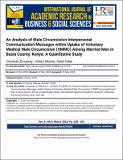| dc.contributor.author | Hellen Mberia Omukule Emojong, Ndeti Ndati | |
| dc.date.accessioned | 2020-12-04T07:54:18Z | |
| dc.date.available | 2020-12-04T07:54:18Z | |
| dc.date.issued | 2018 | |
| dc.identifier.uri | https://repository.maseno.ac.ke/handle/123456789/3279 | |
| dc.description.abstract | Voluntary Medical Male circumcision (VMMC) reduces risk of heterosexually acquired HIV. Kenya
adopted VMMC as an HIV intervention in 2008 and has been making remarkable progress
towards achieving its male circumcision target. However, its uptake is lowest among older and
married men. The main objective of this paper is to examine the nature interpersonal
communication messages and their influence on uptake of VMMC among married men in Teso
South Sub County in Western Kenya. Teso Sub County is among the sub counties with low male
circumcision prevalence and high HIV/AIDS prevalence thus a target of the VMMC programme.
The survey was carried out between June 15 and July 13, 2017 targeting married men aged
between 20 and 49 years. Key constructs and thematic frameworks were developed using health
belief model (HBM) and Extended Parallel Process Model (EPPM) and presented verbatim using
the participants own words. Based on male circumcision interpersonal communication messages,
the findings show that majority respondents including those circumcised perceived HIV/AIDS to
International Journal of Academic Research in Business and Social Sciences
Vol. 8 , No. 3, March 2018, E-ISSN: 2222-6990 © 2018 HRMARS
130
be severity and believed they were susceptibility to it. Self-efficacy (confidence in performing a
behavior), and especially response efficacy (the belief of efficacious of message) regarding
acceptance of VMMC as a preventive measure were the most important correlates of perception.
Low response efficacy was the critical problems in adoption of VMMC. Majority of those who had
sought VMMC did it for other reasons such as peer pressure, penis appearance, sexual
satisfaction and penile hygiene and not for HIV prevention. Among the uncircumcised
respondents, majority of those who expressed willingness to adopt male circumcision said it will
be for other reasons, not HIV prevention. | en_US |
| dc.publisher | Semanticscholar | en_US |
| dc.subject | Interpersonal Communication, Voluntary Medical Male Circumcision, HIV/AIDS, Married Men, Qualitative Data, Kenya. | en_US |
| dc.title | An Analysis of Male Circumcision Interpersonal Communication Messages within Uptake of Voluntary Medical Male Circumcision (VMMC) Among Married Men in Busia County, Kenya: A Quantitative Study | en_US |
| dc.type | Article | en_US |

